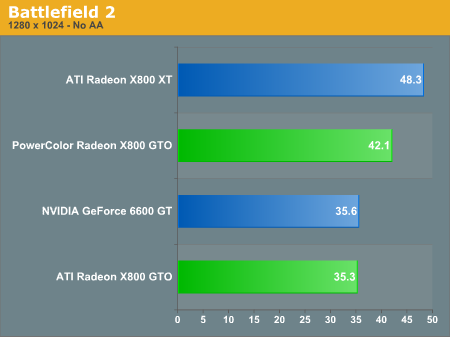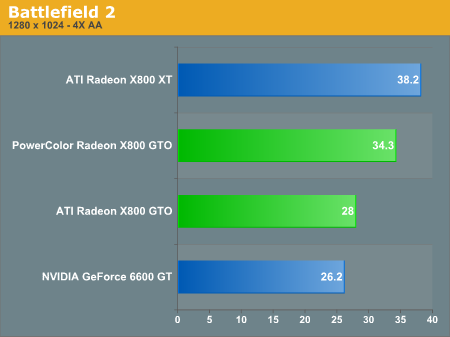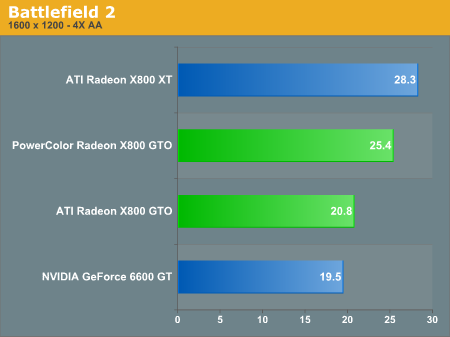ATI Radeon X800 GTO Mini Roundup: Sapphire, Connect3D, and PowerColor
by Josh Venning on December 26, 2005 12:05 AM EST- Posted in
- GPUs
Test Setup/Battlefield 2 Performance
We tested the X800 GTO alongside a variety of cards, and we used two resolutions: 1280x1024 and 1600x1200. We also tested each resolution with 4XAA and 8XAF for a total of 4 numbers per game. We would like to mention that as a general rule, a game is more or less unplayable under about 29 or 30 frames per second (depending on the game); however, each person has their limit. We've found that for fast-paced games like Battlefield 2 and Halflife 2, 35 fps and above will allow for enjoyable gameplay, while games like Splinter Cell would be just as fun at a much lower fps. This ultimately, of course, is all up to the personal preference of the player.
Here is the system that we used for testing:
MSI K8N Neo4 Platinum/SLI motherboard
AMD Athlon 64 FX-55 Processor
2x512MB OCZ 2-2-2-6 1T DDR400 RAM
Seagate 7200.7 120 GB Hard Drive
OCZ 600 W PowerStream Power Supply
Starting out our tests with Battlefield 2, we see that the PowerColor X800 GTO 16 scores significantly higher than the standard X800 GTO. Note that because the other three X800 GTOs are all clocked at stock speeds (400/490), they are all represented as the reference ATI Radeon X800 GTO. Keep in mind that the X800 XT is a much higher priced part, but in Bf2, the PowerColor GTO gets framerates that aren't far behind it. This is interesting when you consider that the X800 XT costs $100 to $200 more than the PowerColor X800 GTO 16 at the time of this writing.
We would see the same type of performance from the other GTOs if we were able to unlock the pixel pipelines to 16, but with PowerColor offering an unlocked part out of the box, there's no chance that you'll end up stuck with 12 pipes.
We tested the X800 GTO alongside a variety of cards, and we used two resolutions: 1280x1024 and 1600x1200. We also tested each resolution with 4XAA and 8XAF for a total of 4 numbers per game. We would like to mention that as a general rule, a game is more or less unplayable under about 29 or 30 frames per second (depending on the game); however, each person has their limit. We've found that for fast-paced games like Battlefield 2 and Halflife 2, 35 fps and above will allow for enjoyable gameplay, while games like Splinter Cell would be just as fun at a much lower fps. This ultimately, of course, is all up to the personal preference of the player.
Here is the system that we used for testing:
MSI K8N Neo4 Platinum/SLI motherboard
AMD Athlon 64 FX-55 Processor
2x512MB OCZ 2-2-2-6 1T DDR400 RAM
Seagate 7200.7 120 GB Hard Drive
OCZ 600 W PowerStream Power Supply
Starting out our tests with Battlefield 2, we see that the PowerColor X800 GTO 16 scores significantly higher than the standard X800 GTO. Note that because the other three X800 GTOs are all clocked at stock speeds (400/490), they are all represented as the reference ATI Radeon X800 GTO. Keep in mind that the X800 XT is a much higher priced part, but in Bf2, the PowerColor GTO gets framerates that aren't far behind it. This is interesting when you consider that the X800 XT costs $100 to $200 more than the PowerColor X800 GTO 16 at the time of this writing.
We would see the same type of performance from the other GTOs if we were able to unlock the pixel pipelines to 16, but with PowerColor offering an unlocked part out of the box, there's no chance that you'll end up stuck with 12 pipes.














27 Comments
View All Comments
Le Québécois - Monday, December 26, 2005 - link
Is it just me or the PowerColor GTO 16 has the exact same spec as the standart ATI Radeon X800XL?AtaStrumf - Monday, December 26, 2005 - link
Almost. X800XL runs at 400/500 vs. 400/490 of the GTO 16. They also both use the same .11 mikron R430 chip.mamisano - Monday, December 26, 2005 - link
Wow, you guys are getting really soft lately. The GTO2's main claim to fame is the ability to unlock the 4 extra pipelines and the tremendous overclocking headroom available. At least give it a try, it can always be flashed back if you experience problems.Second, did you actually remove any of the HS units to determine the actual core installed on each card? That and a list of brand/speed of memory used on each one would have been very beneficial to the overall review.
Seems to be another in a line of reviews with decreasing quality.
AtaStrumf - Monday, December 26, 2005 - link
I absolutely agree! Very low quality review and VERY, VERY late!!!Zoomer - Monday, December 26, 2005 - link
I research all of these cards before settling with the c3d gto - and I would have gotten the gto2 if it was avaliable.Sapphire GTO2
R480
Samsung 1.6ns
C3D GTO
R423
Samsung 2.0ns
PowerColor
R430
Samsung 2.0ns
An article at anandtech commented on why the Powercolor card (the R430) can't hit high clocks - although it uses a smaller process, the 130nm uses a low k process. The 110nm process does NOT. The article goes on to say that this shrink was to cut costs, at the expense of clock speed.
However, it is interesting to note that the die shrink didn't do anything to reduce power draw. An investigation into the voltages the R430 is running at is in order. :)
One more thing to note - the c3d has VIVO, with a rage theatre chip soldered (as usual) on the board.
I can't remember the ones for ultimtate, but the fireblade should also be using 1.6ns rams.
tuteja1986 - Monday, December 26, 2005 - link
I wonder why anandtech never did it earlier ;(coldpower27 - Monday, December 26, 2005 - link
At least the different manufacturer made it interesting, and customized the boards a little bit to differentiate from one another and not stick to the reference design.The 6800 GS is quite the competitor for the X800 GTO, and from my persepctive is a better buy if you want something straight out of the box save for the Powercolor X800 GTO 16. Though there is also the XFX Edition clocked at 485/1100 to worry about.